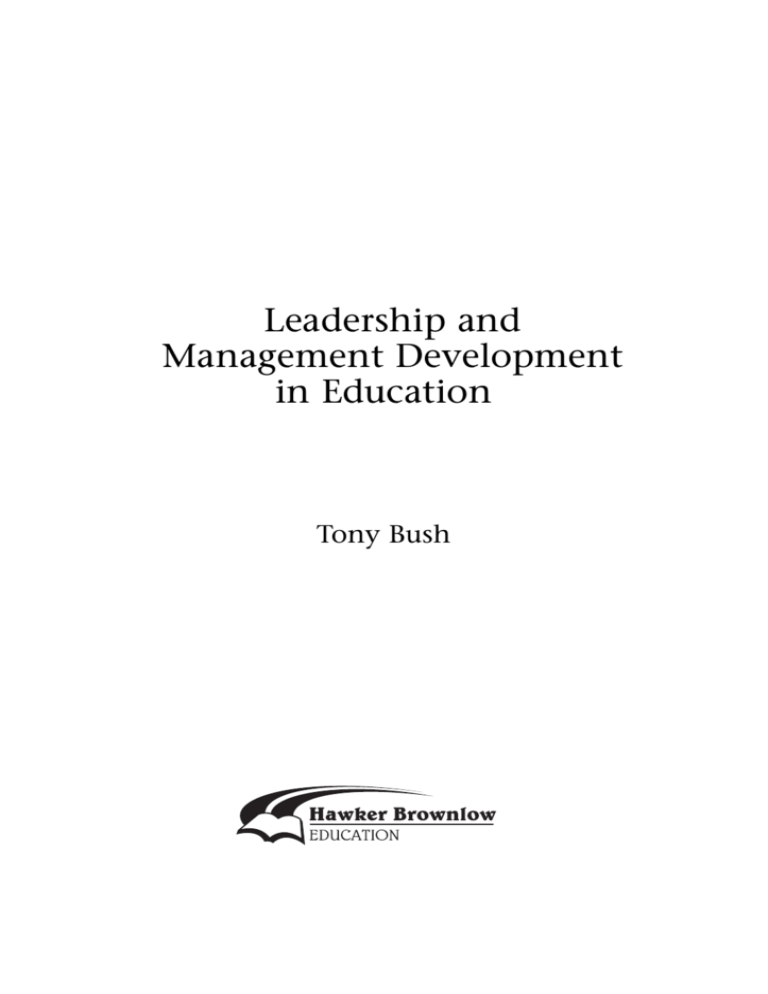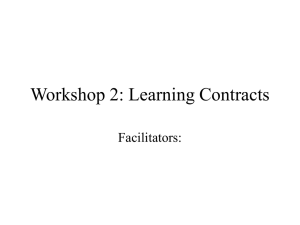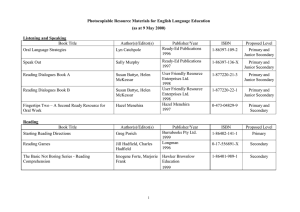Leadership and Management Development in Education
advertisement

Leadership and Management Development in Education Tony Bush Contents Notes on the author Series Editor’s foreword Preface v vii ix 1 Leadership and school improvement Introduction Leadership or management? Leadership and school improvement Conclusion 2 Models of educational leadership Introduction Models of educational leadership and management Linking the models to leadership development 9 9 10 20 3 The significance of leadership and management development Introduction The expanded role of school leaders The increasing complexity of school contexts Leadership preparation as a moral obligation Effective leadership preparation makes a difference Conclusion 25 25 26 28 29 30 32 The curriculum for leadership development: content and process Introduction The content of leadership development programmes Leadership development processes Conclusion: content or process? 33 33 34 41 49 Preparing and supporting leaders in developed countries Introduction Leadership succession 53 53 53 4 5 © 2008 Hawker Brownlow Education • SA4170 1 1 1 6 8 iii iv LEADERSHIP AND MANAGEMENT DEVELOPMENT IN EDUCATION Leadership preparation Leadership selection Induction for leadership Leadership training and development Overview 56 61 65 67 70 6 The National College for School Leadership Introduction Leadership development in England before the NCSL The Leadership Development Framework The National Professional Qualification for Headship Strengths and achievements of the NCSL Weaknesses and limitations of the NCSL Conclusion 73 73 74 75 77 79 82 86 7 Preparing and supporting leaders in developing countries 89 Introduction 89 Preparation for new principals 94 Selection and induction 98 The experience of new principals 101 In-service development 104 Conclusion: a new approach to school leadership in developing countries 104 8 The impact of leadership development Introduction The purpose of leadership and management development Evaluation and impact models Evaluating the impact of leadership development Overview 107 107 107 114 117 122 9 The future of leadership development Introduction: leadership matters Content or process? Leadership and values Towards a model for leadership development Overview 125 125 126 128 129 136 References Author index Subject index 139 159 163 © 2008 Hawker Brownlow Education • SA4170 Preface The significance of effective leadership and management for the successful operation of schools and colleges is widely acknowledged in the twenty-first century. There is growing recognition that the quality of leaders, and leadership, is critical if schools are to produce the best possible outcomes for their learners, and their stakeholders. The longstanding appreciation of the vital role of teachers is belatedly being matched by an understanding that skilled leadership is also required if schools and colleges are to thrive. The traditional view in many countries is that school principals and senior staff need only to be qualified and experienced teachers. However, there is now an emerging recognition that leadership is a parallel, if not separate, profession and requires specific preparation. This has led many countries to introduce formal development opportunities for aspiring and practising principals. In countries as diverse as Canada, England, France, Scotland and the USA, a formal leadership qualification is required before senior leaders take up their posts. Elsewhere, there is more reliance on in-service opportunities. The nature of the development process varies in line with the specific context, but the overall trend is towards preparing and developing leaders as a key dimension of school improvement. The landscape of leadership development in England has been transformed by the opening, and subsequent expansion, of the National College for School Leadership (NCSL). The College provides a raft of programmes for middle leaders, deputy heads, aspiring heads, new heads, experienced leaders and teams. This ambitious provision is supported by an active research function. The NCSL has had a major impact on school leadership in England and has also influenced change in many other countries. This book examines the reasons for the expansion of leadership preparation and training, and assesses the various modes of development in use in many countries. It is underpinned by the view that leaders should have an entitlement to appropriate preparation and support for their important and onerous role in leading educational change. To appoint school principals without specific preparation is a gamble, and we should not gamble with children’s education. © 2008 Hawker Brownlow Education • SA4170 ix x LEADERSHIP AND MANAGEMENT DEVELOPMENT IN EDUCATION Chapter 1 sets the scene by discussing the reasons for the enhanced global interest in the role of school leaders. It assesses the differences between leadership and management, and argues that both are essential if schools and colleges are to thrive. It also examines the evidence that effective leadership is critical to school improvement. While the importance of leadership and management is increasingly recognised, much less is known about which leadership behaviours are most likely to promote successful schooling. Chapter 2 examines the various models of leadership and assesses the evidence of their effectiveness. There is great interest in ‘instructional leadership’ because of the widespread view that the main function of schools is to promote student learning. Transformational leadership is widely advocated because of its potential to harness stakeholder support for the school’s (or leader’s) vision but there is some concern that this may be a vehicle for imposing leaders’, or governments’, priorities on teachers, pupils and communities. These and other models are subject to scrutiny in this chapter. Chapter 3 addresses the significance of leadership and management development in education. It points to the emergence of four imperatives; the expanded role of school leaders, the increasing complexity of school contexts, the moral case for leadership preparation, and the growing evidence that effective development makes a difference. Chapter 4 discusses the curriculum for leadership development. There is great diversity in the content of preparation and training programmes but there is an emerging ‘core’ around the need to provide for the management of teaching and learning, an awareness of the legal and policy framework for leadership, the need for effective management of people and resources, and a recognition that efficient administration is required to keep schools ‘on track’. In the twenty-first century, there has been increasing interest in the ‘delivery’ of programmes and on the processes by which leadership learning is enhanced. Networking, mentoring, coaching and facilitation are among the strategies used in several countries and there is growing evidence of their effectiveness. Chapter 5 focuses on preparation and support for leaders in developed countries. These are mostly rich nations and decisions about the shape and scope of leadership preparation are based on perceptions of need and appropriateness rather than being circumscribed by limited funding. The chapter examines five stages of development: leadership succession, preparation, selection, induction and ongoing in-service development. As we noted earlier, the NCSL is a powerful symbol of the growing significance of leadership development. Chapter 6 examines the background to the opening of the College and notes the significance of its Leadership Development Framework, which helped to move the debate from the preparation of principals to a wider appreciation of the need to develop leaders at all levels and career stages. The many achievements of NCSL are discussed along with the various criticisms of its work. © 2008 Hawker Brownlow Education • SA4170 PREFACE xi Chapter 7 shifts the debate to developing countries. Their need for effective leadership is even greater than in rich Western nations but their resources are very limited. Pre-service preparation is rare and the limited development opportunities are mainly confined to in-service activity. Selection criteria are usually confined to teaching experience, while induction for new principals is limited and often inadequate. Ongoing support for school leaders is uneven and principals sometimes feel isolated and beleaguered. The chapter concludes with a recommendation that donor bodies give much more attention to school leadership preparation and development. Chapter 8 examines the impact of leadership development. While its importance is widely acknowledged, specific evidence of its effects are limited. The chapter revisits the purposes of leadership development in order to determine criteria for evaluation. It assesses various models of evaluation and impact, and considers the emerging evidence that leadership preparation and development do make a difference to school and learning outcomes. Chapter 9 provides an overview of this important issue. It claims that leadership matters and revisits the debate about content and process. It examines the relationship between leadership and values, and considers its implications for development. It outlines a model for school leadership development and concludes that preparation has been ‘nationalised’. I am grateful to the many people who have contributed to the development of this volume. David Middlewood has been a supportive series editor, and has provided many valuable suggestions on draft chapters. Derek Glover and I have worked together for many years and his literature reviews underpin much of the analysis in this book. I am also grateful for the more general support of many other colleagues in England and in many other countries. I have been fortunate to be able to conduct research in this field for several bodies, including the NCSL. Of course, the opinions expressed in this book are mine and may not represent the views of the College. Finally, I wish to thank those close to me, especially Cha and Graham. © 2008 Hawker Brownlow Education • SA4170 1 Leadership and school improvement Introduction There is great interest in educational leadership in the early part of the twentyfirst century. This is because of the widespread belief that the quality of leadership makes a significant difference to school and student outcomes. In many parts of the world, including both developed and developing countries, there is recognition that schools require effective leaders and managers if they are to provide the best possible education for their students and learners. As the global economy gathers pace, more governments are realising that their main assets are their people and that remaining, or becoming, competitive depends increasingly on the development of a highly skilled workforce. This requires trained and committed teachers but they, in turn, need the leadership of highly effective principals with the support of other senior and middle managers. Leadership or management? Educational leadership and management are fields of study and practice concerned with the operation of schools and other educational organisations. Bolam (1999: 194) defines educational management as ‘an executive function for carrying out agreed policy’. He differentiates management from educational leadership which has ‘at its core the responsibility for policy formulation and, where appropriate, organisational transformation’ (p. 194). Writing from an Indian perspective, Sapre (2002: 102) states that ‘management is a set of activities directed towards efficient and effective utilisation of organisational resources in order to achieve organisational goals’. Glatter (1979: 16) argues that management studies are concerned with ‘the internal operation of educational institutions, and also with their relationships with their environment, that is, the communities in which they are set, and with the governing bodies to which they are formally responsible’. In other words, managers in schools and colleges have to engage with both internal and © 2008 Hawker Brownlow Education • SA4170 1 2 LEADERSHIP AND MANAGEMENT DEVELOPMENT IN EDUCATION external audiences in leading their institutions. This statement delineates the boundaries of educational management but leaves open questions about the nature of the subject. The present author has argued consistently (for example, Bush 2003) that educational management has to be centrally concerned with the purpose or aims of education. These purposes or goals provide the crucial sense of direction, which should underpin the management of educational institutions. Management is directed at the achievement of certain educational objectives. Unless this link between purpose and management is clear and close, there is a danger of ‘managerialism’, ‘a stress on procedures at the expense of educational purpose and values’ (Bush 1999: 240). ‘Management possesses no superordinate goals or values of its own. The pursuit of efficiency may be the mission statement of management – but this is efficiency in the achievement of objectives which others define’ (Newman and Clarke 1994: 29). Managing towards the achievement of educational aims is vital but these must be purposes agreed by the school and its community. If managers simply focus on implementing external initiatives, they risk becoming ‘managerialist’. Successful management requires a clear link between aims, strategy and operational management. The process of deciding on the aims of the organisation is at the heart of educational management. In some settings, aims are decided by the principal or headteacher, often working in association with senior colleagues and perhaps a small group of lay stakeholders. In many schools and colleges, however, goal setting is a corporate activity undertaken by formal bodies or informal groups. The school’s aims are often encapsulated in a ‘vision’ or ‘mission statement’. School and college aims are inevitably influenced by pressures emanating from the wider educational environment and this leads to questions about the viability of school ‘visions’. Many countries, including England and Wales, have a national curriculum and such government prescriptions leave little scope for schools to decide their own educational aims. Institutions may be left with the residual task of interpreting external imperatives rather than determining aims on the basis of their own assessment of student need. Governments have the constitutional power to impose their will but successful innovations require the commitment of those who have to implement these changes. If teachers and leaders believe that an initiative is inappropriate for their children or students, they are unlikely to implement it with enthusiasm. Hence, governments would like schools to have visionary leadership as long as the visions do not depart in any significant way from government imperatives (Bush 2003). Leadership A central element in many definitions of leadership is that there is a process of influence. © 2008 Hawker Brownlow Education • SA4170 LEADERSHIP AND SCHOOL IMPROVEMENT 3 Most definitions of leadership reflect the assumption that it involves a social influence process whereby intentional influence is exerted by one person [or group] over other people [or groups] to structure the activities and relationships in a group or organisation. (Yukl 2002: 3) Leadership may be understood as ‘influence’ but this notion is neutral in that it does not explain or recommend what goals or actions should be sought through this process. However, certain alternative constructs of leadership focus on the need for leadership to be grounded in firm personal and professional values. Wasserberg (2000: 158), for example, claims that ‘the primary role of any leader [is] the unification of people around key values’. Day et al.’s (2001) research in 12 ‘effective’ schools in England and Wales concludes that ‘good leaders are informed by and communicate clear sets of personal and educational values which represent their moral purposes for the school’ (p. 53). Vision is increasingly regarded as an essential component of effective leadership. Beare et al. (1992) draw on the work of Bennis and Nanus (1985) to articulate ten ‘emerging generalisations’ about leadership, four of which relate directly to vision: 1. Outstanding leaders have a vision for their organisations. 2. Vision must be communicated in a way which secures commitment among members of the organisation. 3. Communication of vision requires communication of meaning. 4. Attention should be given to institutionalising vision if leadership is to be successful. These generalisations are essentially normative views about the centrality of vision for effective leadership. There is a high level of support for the notion of visionary leadership but Foreman’s (1998) review of the concept shows that it remains highly problematic. Kouzes and Posner (1996: 24) say that ‘inspiring a shared vision is the leadership practice with which [heads] felt most uncomfortable’, while Fullan (1992: 83) adds that ‘vision building is a highly sophisticated dynamic process which few organisations can sustain’. It is evident that the articulation of a clear vision has the potential to develop schools but the empirical evidence of its effectiveness remains mixed. A wider concern relates to whether school leaders are able to develop a specific vision for their schools, given government influence on many aspects of curriculum and management. Distinguishing educational leadership and management The concepts of leadership and management overlap. Cuban (1988) provides one of the clearest distinctions between leadership and management. He links © 2008 Hawker Brownlow Education • SA4170 4 LEADERSHIP AND MANAGEMENT DEVELOPMENT IN EDUCATION leadership with change, while management is seen as a maintenance activity. He also stresses the importance of both dimensions of organisational activity: By leadership, I mean influencing others’ actions in achieving desirable ends. Leaders are people who shape the goals, motivations, and actions of others. Frequently they initiate change to reach existing and new goals … Leadership … takes … much ingenuity, energy and skill. (p. xx) Managing is maintaining efficiently and effectively current organisational arrangements. While managing well often exhibits leadership skills, the overall function is toward maintenance rather than change. I prize both managing and leading and attach no special value to either since different settings and times call for varied responses. (p. xx) Day et al.’s (2001) study of 12 ‘effective’ schools leads to the discussion of several dilemmas in school leadership. One of these relates to management, which is linked to systems and ‘paper’, and leadership, which is perceived to be about the development of people. Bush (1998, 2003) links leadership to values or purpose while management relates to implementation or technical issues. Leadership and management need to be given equal prominence if schools and colleges are to operate effectively and achieve their objectives. While a clear vision may be essential to establish the nature and direction of change, it is equally important to ensure that innovations are implemented efficiently and that the school’s residual functions are carried out effectively while certain elements are undergoing change. Decentralisation and self-management Educational institutions operate within a legislative framework set down by national, provincial or state parliaments. One of the key aspects of such a framework is the degree of decentralisation in the educational system. Highly centralised systems tend to be bureaucratic and to allow little discretion to schools and local communities. Decentralised systems devolve significant powers to subordinate levels. Where such powers are devolved to the institutional level, we may speak of ‘self-management’. Lauglo (1997) links centralisation to bureaucracy and defines it as follows: Bureaucratic centralism implies concentrating in a central (‘top’) authority decision-making on a wide range of matters, leaving only tightly programmed routine implementation to lower levels in the organisation ... a ministry could make decisions in considerable detail as to aims and objectives, curricula and teaching materials to be used, prescribed methods, © 2008 Hawker Brownlow Education • SA4170











